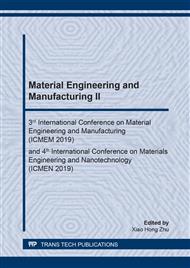[1]
T. Chiba, Y. Pu, and J. Kido. (2015). Solution‐Processed White Phosphorescent Tandem Organic Light‐Emitting Devices. Advanced Materials, 27, 4681-4687.
DOI: 10.1002/adma.201501866
Google Scholar
[2]
M.A. Green: High Efficiency Silicon Solar Cells (Trans Tech Publications, Switzerland 1987). Strunk, W., & White, E. B. (1979). The Elements of Style (3rd ed.). New York: Macmillan.
Google Scholar
[3]
Y. Mishing NY. (2004). in: Diffusion Processes in Advanced Technological Materials, edtied by D. Gupta Noyes Publications/William Andrew Publising, Norwich.
Google Scholar
[4]
G. Henkelman, G.Johannesson and H. Jónsson. (2000). in: Theoretical Methods in Condencsed Phase Chemistry, edited by S.D. Schwartz, volume 5 of Progress in Theoretical Chemistry and Physics, chapter, 10, Kluwer Academic Publishers.
Google Scholar
[5]
P.G. Clem, R. J. Ong, and J. T. Dawley. (2003). Chemical solution deposition of biaxially oriented (Ba,Sr) TiO3 thin films on Ni. Journal of Materials Research, 18(10), 2310-2317.
DOI: 10.1557/jmr.2003.0324
Google Scholar
[6]
P.G. Clem, M. Rodriguez, J.A. Voigt and C.S. Ashle. (2001). U.S. Patent 6,231,666.
Google Scholar
[7]
Y. Lin, J. Wang, Z.G. Zhang, H. Bai, Y. Li, D. Zhu and X. Zhan. (2015). An electron acceptor challenging fullerenes for efficient polymer solar cells. Advanced Materials, 27, 1170.
DOI: 10.1002/adma.201404317
Google Scholar
[8]
Q.C. Dong, F.F. Tai, H. Lian, B. Zhao, Z. Zhong, Z. Chen, J. X. Tang and F. R. Zhu. (2017). Realization of efficient light out-coupling in organic light-emitting diodes with surface carbon-coated magnetic alloy nanoparticles. Nanoscale, 9, 2875–2882.
DOI: 10.1039/c6nr09769c
Google Scholar
[9]
S. Jung, S. Lee, M. Song, D.-G. Kim, D. S. You, J.-K. Kim, C. S. Kim, T.-M. Kim, K.-H. Kim, J.-J. Kim and J.-W. Kang. (2014). Extremely Flexible Transparent Conducting Electrodes for Organic Devices Advanced energy materials, 4, 1–8.
DOI: 10.1002/aenm.201470005
Google Scholar
[10]
W. H. Choi, H. L. Tam, F. Zhu, D. Ma, H. Sasabe and J. Kido. (2013). High performance semitransparent phosphorescent white organic light emitting diodes with bi-directional and symmetrical illumination. Applied Physics Letters, 102, 153308.
DOI: 10.1063/1.4802723
Google Scholar
[11]
W. S. Jeon, T. J. Park, S. Y. Kim, R. Pode, J. Jang and J. H. Kwon. (2008). Ideal host and guest system in phosphorescent OLEDs. Applied Physics Letters, 93, 063303.
DOI: 10.1016/j.orgel.2008.11.012
Google Scholar
[12]
S. Reineke, K. Walzer and K. Leo. (2007). Reduced efficiency roll-off in high-efficiency hybrid white organic light-emitting diodes, Physical Review B: Condens. Matter Mater. Physics, 75, 125328.
DOI: 10.1063/1.2836772
Google Scholar
[13]
L. Xu, C. W. Tang, and L. J. Rothberg. (2016). High efficiency phosphorescent white organic light-emitting diodes with an ultra-thin red and green co-doped layer and dual blue emitting layers. Organic Electronics, 32.
DOI: 10.1016/j.orgel.2016.02.010
Google Scholar
[14]
Y. Lv, P. Zhou, N. Wei, K. Peng, J. Yu, B. Wei, Z. Wang and C. Li. (2013). Improved hole-transporting properties of Ir complex-doped organic layer for high-efficiency organic light-emitting diodes, Organic Electronics, 14(1).
DOI: 10.1016/j.orgel.2012.09.042
Google Scholar
[15]
S. Scholz, R. Meerheim, K. Walzer and K. Leo. (2008). Chemical degradation mechanisms of organic semiconductor devices, Proc. SPIE. 6999, 69991B-1.
DOI: 10.1117/12.778875
Google Scholar


